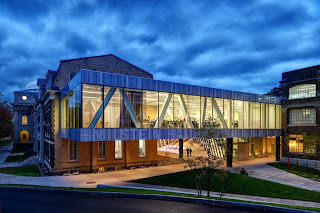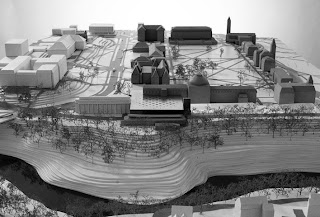2semesters 150entradas 150posts 2semestres
Milstein Hall . Cornell AAP . ITHACA
OMA . Cornell AAP . photos: Matthew Carbone . William Staffeld . Mike Moyer . Cornell AAP
Occupying four distinct buildings at the northern periphery of Cornell's Arts Quad, the College for Architecture, Art and Planning (AAP) is currently a fragmented area, dislocated from the energy of university life. The new Milstein Hall – a 14,000m2 complex containing much-needed studio, exhibition and crit space, an auditorium and a new Fine Arts Library – is conceived not as a symbolic, isolated addition to the campus but as a connecting structure: a large elevated horizontal plate that links the second levels of Sibley and Rand Halls and cantilevers over University Avenue, reaching towards the Foundry building. Where a car park once stood between Sibley and Rand, a contiguous, multi-layer system of buildings and plazas will unite the disparate elements of the AAP, creating a vibrant public space adjacent to the campus’s most beautiful feature, just to the north – the Fall Creek Gorge.
The four existing buildings of the AAP – Rand, Sibley, the Foundry and Tjaden Hall – exhibit varying architectural styles but share a single typology: linear, corridor-based buildings that segregate the AAP’s disciplines in closed rooms behind a labyrinth of entrances, security codes and dead ends. Milstein Hall provides a type of space currently absent from the campus: a wide-open expanse that stimulates the interaction of programs, and allows flexibility over time. Within Milstein Hall's upper plate, which has access to Rand and Sibley, areas are defined not by walls but by subtle manipulations of the section that trigger particular uses: a sunken area for the library, raised areas for crit spaces, and open spaces for studios – all suffused with light from floor-to-ceiling windows and a grid of skylights.
The roof of the upper plate, visible from the third floor of Sibley, Rand and Baker Lab, is an open platform with views of the gorge and the surrounding campus, and is gridded with vegetation that becomes denser in the direction of the gorge.
Milstein Hall is intended as a building with hidden depths: the floor of the upper plate is punctured by the bulging ceiling of the lower plate, opening a route to the lower levels. This bump continues to slope downwards on both sides, dissecting the lower plate into three areas with varying heights and depths: the lobby (on the Rand side of the building); the basement, with computer labs and meeting areas (in the middle); and a 282-seat auditorium that gradually rises to a double-height space (on the Sibley side). Like the upper plate, the auditorium has floor-to-ceiling windows, granting views both into the lecture theatre for passersby and out of it for students.
Outside the auditorium, a sunken garden, exhibition space and plaza extends to the central, domed portion of Sibley Hall, reinforcing its importance and creating, for the first time, a coherent entry sequence from the north into AAP. Milstein Hall's sheltering cantilevers, both to the north and the south east, similarly define new areas of public space and encourage new ways to navigate the interlinked AAP.
OMA . Cornell AAP . photos: Matthew Carbone . William Staffeld . Mike Moyer . Cornell AAP
Occupying four distinct buildings at the northern periphery of Cornell's Arts Quad, the College for Architecture, Art and Planning (AAP) is currently a fragmented area, dislocated from the energy of university life. The new Milstein Hall – a 14,000m2 complex containing much-needed studio, exhibition and crit space, an auditorium and a new Fine Arts Library – is conceived not as a symbolic, isolated addition to the campus but as a connecting structure: a large elevated horizontal plate that links the second levels of Sibley and Rand Halls and cantilevers over University Avenue, reaching towards the Foundry building. Where a car park once stood between Sibley and Rand, a contiguous, multi-layer system of buildings and plazas will unite the disparate elements of the AAP, creating a vibrant public space adjacent to the campus’s most beautiful feature, just to the north – the Fall Creek Gorge.
The four existing buildings of the AAP – Rand, Sibley, the Foundry and Tjaden Hall – exhibit varying architectural styles but share a single typology: linear, corridor-based buildings that segregate the AAP’s disciplines in closed rooms behind a labyrinth of entrances, security codes and dead ends. Milstein Hall provides a type of space currently absent from the campus: a wide-open expanse that stimulates the interaction of programs, and allows flexibility over time. Within Milstein Hall's upper plate, which has access to Rand and Sibley, areas are defined not by walls but by subtle manipulations of the section that trigger particular uses: a sunken area for the library, raised areas for crit spaces, and open spaces for studios – all suffused with light from floor-to-ceiling windows and a grid of skylights.
The roof of the upper plate, visible from the third floor of Sibley, Rand and Baker Lab, is an open platform with views of the gorge and the surrounding campus, and is gridded with vegetation that becomes denser in the direction of the gorge.
Milstein Hall is intended as a building with hidden depths: the floor of the upper plate is punctured by the bulging ceiling of the lower plate, opening a route to the lower levels. This bump continues to slope downwards on both sides, dissecting the lower plate into three areas with varying heights and depths: the lobby (on the Rand side of the building); the basement, with computer labs and meeting areas (in the middle); and a 282-seat auditorium that gradually rises to a double-height space (on the Sibley side). Like the upper plate, the auditorium has floor-to-ceiling windows, granting views both into the lecture theatre for passersby and out of it for students.
Outside the auditorium, a sunken garden, exhibition space and plaza extends to the central, domed portion of Sibley Hall, reinforcing its importance and creating, for the first time, a coherent entry sequence from the north into AAP. Milstein Hall's sheltering cantilevers, both to the north and the south east, similarly define new areas of public space and encourage new ways to navigate the interlinked AAP.









































































.jpg)











.jpg)
.jpg)
.jpg)

.jpg)
.jpg)
.jpg)

.jpg)
.jpg)


2 comentarios :
Impresionante OMA, creando un "nuevo mundo" en una institución universitaria fragmentada y con pérdida de su identidad. El segundo video muestra muy bien el planteamiento estructural que define de manera tan brutal la nueva pieza.
Parece que para los estudiantes es un lugar de encuentro y estímulo.
este edificio como algunos otros de Oma, entre tantos, me hacen pensar en que son geniales, y al mismo tiempo no encuentro qué tienen de lindos o de buenos.... es algo contradictorio, pero las fotos no me dicen nada -los planos se ven muy chiquitos así que puedo hablar- el interior de este contenedor -biblioteca?- sum?- alrededor de unas gradas de clase o auditorium- me hace acordar al easy homecenter con su piso cementicio y el techo de chapa con los tubos...alguien me ilumine distinto por favor...
Publicar un comentario